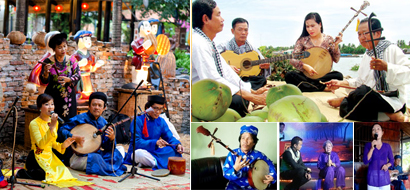(Cinet)- “Don ca tai tu” – a traditional improvisational chamber music - emerged in the south at the end of the 19th century. Coming to life no more than two centuries ago and becoming much loved by southerners of Vietnam, “Don ca tai tu” is deeply rooted in the culture and spirits of locals and considered a traditional music of the nation.
“Don ca tai tu” - traditional improvisational chamber music - emerged in the south at the end of the 19th century. It is now performed mainly in two places, taverns and tourist sites.
In the past, the music was performed to entertain high-ranking officials when they held parties. As time passed, Tai tu performers began to participate in exchanges instead of just having fun at parties. Tai tu performers can perform in a group or solo. In the past, performers is usually sat and performed solo but nowadays, they usually form a band and stand up for performances, which have evolved into Cai luong or reformed theatre”.
A traditional Tai tu orchestra includes a Vietnamese two-string guitar, a Vietnamese 16-string zither, a Chinese four-string lute, a Vietnamese two-string fiddle, a monochord and a flute. Since the middle of the 20th century, guitar and violin - two Western musical instruments - have been added to the orchestra. In order to make these new musical instruments compatible with the others, the guitars frets have been made deeper, and both instruments have been retuned. All Tai tu musicians have to learn by heart the basic tunes of their repertoire from which they can improvise, while still maintaining the music’s integrity. This kind of music is performed not only at parties, but also in the post-harvest time. It is played in the shade of trees or on boats, on a bright moonlit night. This southern amateur music cannot be found on modern stages or in cultural or tourism festivals. This genre of chamber music is usually performed on ‘plank beds’ in living rooms in southern traditional houses.
As to the vision of “Don ca tai tu”, Prof. Dr Tran Van Khe stressed that “Don ca tai tu” is the ‘soul of the South’s culture’. It will never be lost into oblivion or disappear. The most important thing is that “Don ca tai tu” must be preserved and developed and prevented from being mutated into new forms. To do that, suitable playgrounds for “Don ca tai tu” must be created, instead of just several festivals or competitions.
Being awarness of an important role of the form of art in Vietnam, some researchers of the domestic and foreign music have tried to collect and summarized some forms of the arts. In 2010, the MOCST has had Document to propose that 19 provinces and cities including HCM City, Can Tho , Binh Phuoc , Vinh Longy, Bac Lieu and Ca Mau has inspected about some intangible cultural heritages in oder to establish Document for recognizing as UNESCO heritage.
In 2013, “Don ca tai tu in the Southern Vietnam” was officially recognized by the UNESCO in list of intangible cultural heritage of humanity.
Recognizing “ Don ca tai tu in the Southern Vietnam” showed that the world highly appreciated a type of music in the Southern Vietnam and affirmed an existence of Vietnamese traditional cultural in the integration period.














COMMENTS